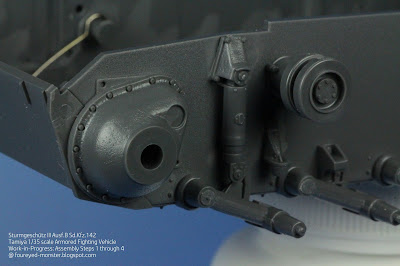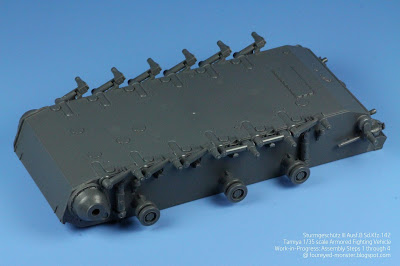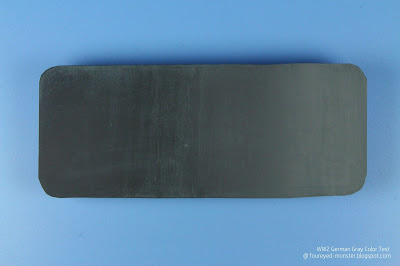Assembly of the Tamiya 1/35 scale Sturmgeschütz III Ausf.B Sd.Kfz.142 began, for me at least, with steps one through four as per the instructions. This series of initial steps focuses on the lower hull and its exterior parts including the suspension arms/springs, return rollers, and rear panel/grille. For a sense of what is involved in putting together the lower hull, other exterior parts yet to be worked on for this section comprise the idler wheels, drive sprockets, road wheels, towing hooks, and tracks. Below is an account of the progress so far at this early stage in the assembly process.
 |
Sturmgeschütz III work-in-progress: Assembly steps 1 through 4 (top/front isometric view)
|
 |
| Sturmgeschütz III work-in-progress: Assembly steps 1 through 4 (top/back isometric view) |
 |
Tamiya Sturmgeschütz III Ausf.B Sd.Kfz.142 assembly instructions, Steps 1 through 4
|
Having had some experience building World War Two (WW2) tanks, I was appreciative of a simple design that ensured the suspension arms did not fall out from the lower hull. Rather than creating a tight fit for the suspension arms into the lower hull, Tamiya had designed an elongated piece of plastic (see below; top half of first photo) which is glued on over the spring arms, on the interior side. This design helps secure the arms and prevent them from falling out of the lower hull, at least not easily.
 |
Interior view of the piece of elongated plastic that is glued over the suspension arms
|
 |
Side view (from left) of the work-in-progress lower hull, showing the attached suspension arms
|
Another interesting design concept by Tamiya was to include suspension springs that are attached to the suspension arms located at the four farthest corners of the lower hull (see below). These springs provide a rudimentary suspension system. As to how effective this system is, I'll only be able to tell when the drive sprockets, idler/road wheels and track has been installed to the lower hull.
 |
'Front-left' section of lower hull; note the suspension arm farthest to the left ...
|
 |
... which on its reverse side (interior) is attached to a suspension spring ...
|
 |
.. which then allows the said suspension arm the ability to absorb some tension ...
|
 |
... when the said arm is depressed upwards towards the upper hull
|
Details on the lower hull are pretty good, especially towards the back end of the lower hull (see below). That is to be expected because the front end of the Sturmgeschütz III's lower hull would've been plain as it's function was dedicated solely to being a lower glacis armor.
 |
'Back-left' section of the lower hull has incredible details ...
|
 |
... which continues on to the rear section of the lower hull ...
|
 |
... and on to the 'back-right' section whose details mirror the opposite side of the lower hull
|
As for both sides the lower hull so far, details are mainly in the form of return rollers, suspension arms and the surface texture of the front protrusions (into which the drive sprockets will eventually be attached). Things will look much busier once the idler/road wheels, drive sprockets, and tracks are attached to the lower hull. These latter parts will likely be painted separately from the lower hull.
 |
| Side view (from right) of the work-in-progress lower hull |
 |
'Front-right' section; note the surface texture on far right protrusion (example of good detail)
|
 |
Front view of the Sturmgeschütz III's work-in-progress lower hull
|
Below are photos showcasing the progress so far as seen from the bottom of the lower hull.
 |
| Sturmgeschütz III work-in-progress: Assembly steps 1 through 4 (bottom/front isometric view) |
 |
| Sturmgeschütz III work-in-progress: Assembly steps 1 through 4 (bottom/back isometric view) |
Apart from the tedium of having to meticulously remove mold lines from the suspension arms, the build has been pretty straightforward so far. As unique as the suspension spring system was, the process of putting them in place was also easy with minor difficulty arising from having to handle the tiny caps that secure the spring in place (see instructions above). So all in all, there has been no major issues or problems thus far. Assembly on the Sturmgeschütz III should continue soon, if I can pry myself from my latest time-sink of reading books, lots of them. So until next time, it's time for me to curl up with a good book or three to read. For now, stay safe dear reader and see you soon.






























.jpg)